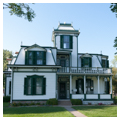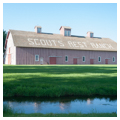You are here
Buffalo Bill Ranch State Historical Park
Located in the vicinity of North Platte, the park, also known as Scout’s Rest Ranch, was the ranch home of William F. Cody, popularly known as “Buffalo Bill.” Cody’s exploits were recorded in several novels that contributed to the legend of Buffalo Bill. As a young man, Cody had various jobs including pony express rider, scout for General Sheridan’s 5th U. S. Calvary, supplier of buffalo meat for construction workers on the Kansas Pacific Railroad, and guide for the hunting expeditions of the Grand Duke Alexis of Russia and the Earl of Dunraven and Mount-Earl. Cody’s first Wild West Show opened in 1883 at the Omaha Fair Grounds and in the years that followed his show toured the United States and Europe entertaining record-breaking crowds. Notable venues included the American Exhibition at Queen Victoria’s Golden Jubilee in 1887 and the 1893 World’s Columbian Exposition in Chicago. It was here, at Scout’s Rest Ranch, that Cody and members of the company rehearsed the show.
Cody purchased the 4,000-acre ranch in 1877 and introduced several new ranching methods, including the selective breeding of imported cattle and horses. Today a portion of the original ranch has been preserved as a state historical park and includes the house, large barn, cob house, and ice house. Patrick Walsh, of North Platte, built the house in 1886 to accommodate Cody and his friends and family, including Cody’s brother-in-law Al Goodman, who managed the ranch. The two-story frame house is one of the few remaining examples of the Second Empire style in Nebraska. While the irregular massing, mansard roof with prominent dormers, and three-story tower topped with a mansard roof and cornice brackets are typical of the style, the house lacks the height and vertical emphasis normally associated with Second Empire design. A rear addition was built in 1909.
The large barn, erected circa 1887, is located a short distance northeast of the house and now contains Wild West Show memorabilia. The two-story building is of wood construction with a gambrel roof and lean-to addition on the north side. A sign dating from Cody’s day, “Scout’s Rest Ranch,” is painted on the roof in large letters and can be seen from a distance. In 1962–1964 the Nebraska Game and Parks Commission renovated and restored both house and barn while converting Scout’s Rest to a State Historical Park.
References
Chatfeild, Penelope, “Scout’s Rest Ranch,” Lincoln County, Nebraska. National Register of Historic Places Inventory–Nomination Form, 1977. National Park Service, U.S. Department of the Interior, Washington, DC.
Writing Credits
If SAH Archipedia has been useful to you, please consider supporting it.
SAH Archipedia tells the story of the United States through its buildings, landscapes, and cities. This freely available resource empowers the public with authoritative knowledge that deepens their understanding and appreciation of the built environment. But the Society of Architectural Historians, which created SAH Archipedia with University of Virginia Press, needs your support to maintain the high-caliber research, writing, photography, cartography, editing, design, and programming that make SAH Archipedia a trusted online resource available to all who value the history of place, heritage tourism, and learning.

























